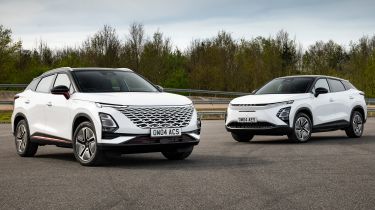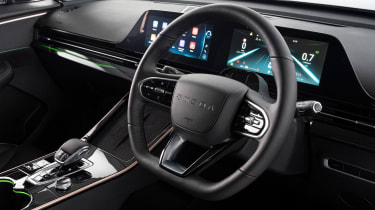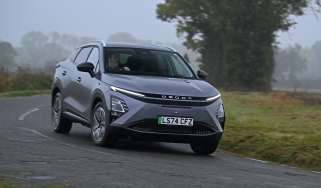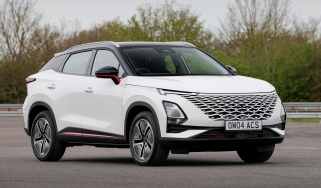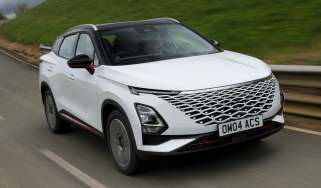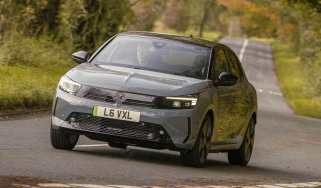New Omoda 5 SUV on sale from £25k or £33k in electric Omoda E5 form
Omoda’s first offering in the UK is meant to steal sales away from the Nissan Qashqai and Renault Symbioz in the mid-size SUV class
Order books are open for the new Omoda 5 mid-size SUV, with prices starting from £25,235 – close to £5,000 less than its chief rival, the Nissan Qashqai. Meanwhile, the all-electric Omoda E5 starts from £33,055. The first customer cars have also arrived in the UK.
If you don’t recognise the Omoda name it’s because the Chinese brand has only just launched in Britain, and the 5/E5 are the first models it's selling here.
Both models are available in just two trim levels Comfort and Noble. Standard equipment includes 18-inch alloy wheels, wireless Apple CarPlay and Android Auto, a 50W wireless charging pad, heated steering wheel, reversing camera and keyless entry. Adaptive cruise control, blind spot detection and traffic jam assist also feature as part of the driver assistance suite, plus Omoda provides a seven-year/100,000-mile warranty on all its cars.
There are a couple of points of difference in the kit list, however. For instance, the petrol-powered Omoda 5 comes with dual 10.25-inch displays and an eight-speaker Sony sound system, while the E5 features a pair of 12.25-inch screens and only higher-spec versions get the Sony stereo.
Upgrading to Noble trim costs £1,800 and adds a sunroof, a 360-degree surround-view camera system, a powered tailgate, heated seats and ambient lighting. It also unlocks the option of 19-inch rims and a two-tone paint scheme.
For now, the Omoda 5 is offered exclusively with a 1.6-litre turbo petrol engine that produces 183bhp and 275Nm of torque, and can return up to 31.4mpg. Power is sent to the front wheels via a seven-speed dual-clutch gearbox, and 0-62mph takes 7.9 seconds. A more efficient hybrid version is coming later.
The Omoda E5 is also front-wheel drive, and is powered by a 201bhp electric motor and 61kWh battery; good for up to 257 miles on a single charge and 0-62mph in 7.6 seconds. The EV’s 80kW maximum charging speed isn’t class-leading, but allows for a 30-80% top-up in 28 minutes.
The E5 can also power external devices such as kettles, cookers and fridges thanks to vehicle-to-load (V2L) capability, while both versions have a 380-litre boot.
Q&A with Peter Matkin
Omoda’s engineering team leader

Peter Matkin, Omoda engineering team leader, spent more than 15 years at Jaguar Land Rover working on cars such as the S-Type, before moving to China in 2010. Here’s his view on how the brand is adapting for Europe.
Q: A big part of Omoda’s fortunes may depend on how quickly it adapts to European tastes. How is that going?
A: It’s not always easy, but I think we have a good line of communication. I’ve been here quite a while now, and I’m the link between our engineers in Germany and the team in Shanghai. We bring vehicles over so the Chinese team can get better context of what we’re discussing or requesting – down to things such as towing, which doesn’t happen here.
Q: What cars are you benchmarking the 5 against?
A: That part of the process works a bit differently in China. In Europe, we’d pick a competitor set fundamentally based on the price bracket of the car; over there, we look at the more luxury end of the spectrum – Mercedes, BMW, Audi, Lexus. It’s not because we achieve the same level, but we’ll get further than if we were to just benchmark cars in the same price bracket. You can get better products and componentry in China, because the business model is different; we get praised on the quality of our materials.
Q: But from an engineering perspective, you must have a particular vehicle in mind?
A: Yes, we do. We see our direct competitor as the Hyundai Kona. We’ve been looking at a lot of the attributes for that model. We’ve tested the Omoda 5 in Germany, Italy and Spain; we haven’t done any specific driving in the UK, but we’re accelerating the launch there. I’m confident the work we’ve done in Europe and in China should carry over; I see no reason why it shouldn’t. We’ve got stiffer anti-roll bars, changed the sub-frame bush, spring rates, steering tuning, damper rates – a lot of work on the vehicle dynamics to make sure it matches European and UK consumers’ tastes.
Click here for our list of the best electric SUVs on sale right now...

